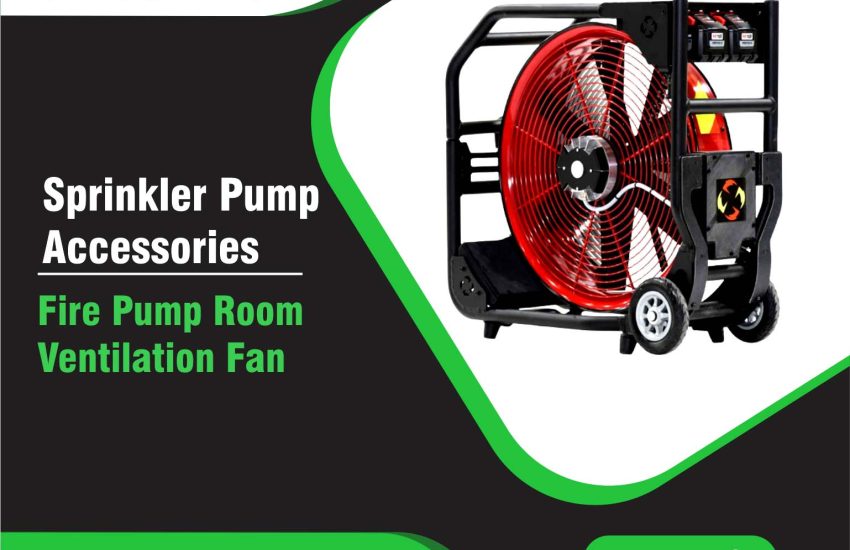Fire Pump Room Ventilation Fan is an essential component for maintaining the safety and efficiency of fire protection systems. It regulates airflow and cooling in the fire pump room, which houses crucial fire suppression equipment. Understanding its specifications, functions, and importance is vital for engineers, facility managers, and safety professionals involved in building design and fire safety.
What is a Fire Pump Room Ventilation Fan?
A Fire Pump Room Ventilation Fan helps provide proper ventilation to the fire pump room, regulating temperature, reducing humidity, and removing fumes or exhaust gases. It ensures that fire pumps and related equipment operate under optimal conditions, preventing overheating, corrosion, and equipment degradation. Proper ventilation keeps the fire pump room efficient and safe, ensuring the fire suppression system is ready when needed.
Key Specifications of Fire Pump Room Ventilation Fans
1. Fan Capacity
Fan capacity is a critical specification. It must be sufficient to maintain an adequate airflow rate, measured in CFM (Cubic Feet per Minute) or m³/h (Cubic Meters per Hour). The required capacity depends on the size of the fire pump room and the amount of heat generated by the equipment. Typically, fan capacities range from 500 CFM to 3,000 CFM, with larger facilities requiring higher capacities.
2. Airflow Design
The fan’s airflow design ensures uniform air distribution across the room. Proper placement of the fan facilitates inlet and exhaust ventilation, helping to prevent heat buildup and maintain required temperature levels. A well-designed airflow system avoids dead zones where stagnant air might accumulate, leading to overheating or reduced equipment performance.
3. Power Source
Fire Pump Room Ventilation Fans usually operate on standard AC (Alternating Current) power. In critical facilities, they may also connect to backup generators or emergency power systems to ensure continuous operation during power outages. The fan must function without interruption during a fire emergency, helping to maintain the fire pump system’s integrity.
4. Fan Speed Control
Some systems feature variable-speed fans that adjust the airflow based on the room’s temperature or humidity levels. Variable speed control optimizes energy consumption and enhances efficiency. Fixed-speed fans may also be used in smaller, less complex installations.
5. Durability and Material
Fire Pump Room Ventilation Fans should be made from durable materials to withstand the demanding environment of the fire pump room. Materials such as galvanized steel, stainless steel, or aluminum offer resistance to corrosion, high temperatures, and harsh operating conditions. The fan blades must also endure high temperatures without compromising performance.
6. Noise Level
While some noise is inevitable, fans should be designed to operate with minimal disruption. Low-noise fans are preferred to avoid interference with other activities in or around the fire pump room. Many ventilation systems are built to meet noise standards, such as dB (decibels), ensuring quiet operation.
7. Safety Features
Safety features are essential in Fire Pump Room Ventilation Fans. These fans should include overload protection and automatic shut-off mechanisms to prevent malfunctions or damage. Fans must also comply with local fire and safety codes, meeting regulations for emergency ventilation systems.
Importance of Ventilation Fans
1. Preventing Overheating
Fire pumps generate significant heat when in operation, so maintaining optimal temperature ranges is essential. Ventilation fans dissipate heat, preventing equipment from overheating and reducing the risk of fire hazards or equipment failure.
2. Protecting Equipment from Corrosion
Poor airflow and high humidity can lead to corrosion in the fire pump room. A ventilation fan maintains dry air circulation, helping preserve the integrity and longevity of fire pumps, motors, and other equipment.
3. Ensuring Operational Readiness
Proper ventilation ensures that the fire pump equipment remains in good working condition, ready to respond during an emergency. It reduces the risk of malfunctions, ensuring reliability when the system is needed most during a fire.
4. Compliance with Safety Codes
Many building codes require proper ventilation for fire pump rooms to ensure safe and efficient operation. Complying with these regulations is necessary for passing inspections and ensuring a building is up to code. Proper ventilation systems also help meet NFPA (National Fire Protection Association) standards for fire protection and safety.
Installation and Maintenance of Fire Pump Room Ventilation Fans
1. Proper Placement
To ensure effective airflow, the fan must be strategically placed in the room. Avoid obstructing the fan’s path, and ensure that it directs airflow away from sensitive equipment to prevent damage.
2. Routine Inspection
Regular maintenance ensures the fan operates at peak efficiency. Inspections should include checking the fan blades for wear, examining the motor, cleaning dust and debris, and verifying smooth fan operation without noise or vibration. Periodic testing of the backup power system is also necessary.
3. Filter Maintenance
Some ventilation systems use air filters to prevent dust and debris from entering the fan. Regular maintenance involves checking the filters, cleaning or replacing them as needed, ensuring the fan operates effectively and prevents contaminants from reaching the fire pump room.
Conclusion
The Fire Pump Room Ventilation Fan is an integral part of fire protection systems. Proper specifications, including capacity, airflow design, power source, and durability, ensure the fan performs efficiently and reliably. By preventing overheating, corrosion, and equipment malfunctions, the ventilation fan helps maintain the operational readiness of fire pumps. Proper installation, regular maintenance, and compliance with safety codes are essential for maximizing the effectiveness of Fire Pump Room Ventilation Fans. When designing or managing fire protection systems, selecting the right fan and specifications is crucial to provide a reliable and efficient solution for fire safety.


